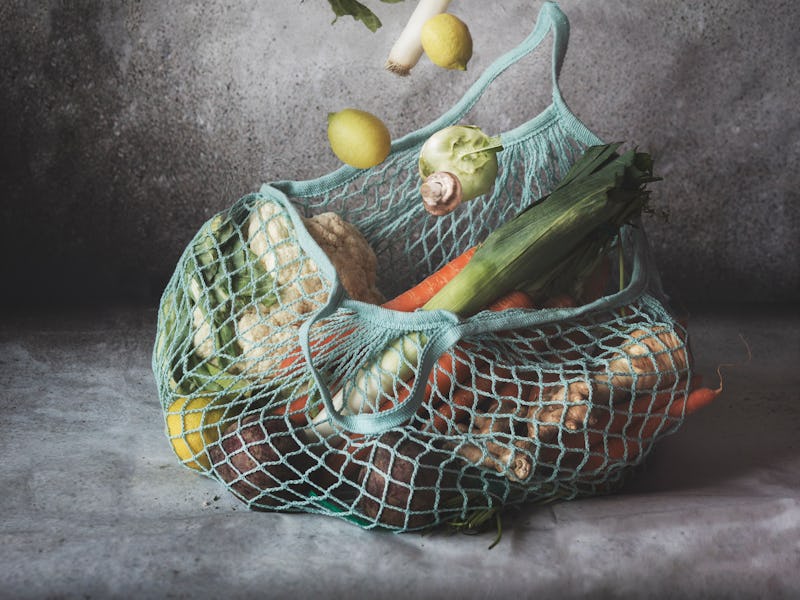To live longer, scientists recommend eating this ‘5-a-day’ mix
Cheat death with the correct amount of fruits and vegetables.

It’s time to shut down both the juice-cleansers and veggie haters in your life in one fell swoop.
There’s a little something for everyone in a study published Monday in the journal Circulation. Researchers from Harvard Medical School and the T.H. Chan School of Public Health suggest we should all be eating a specific magic number of colorful fruit and vegetable servings every day.
The optimal lineup is daily groups of five: three vegetables and two fruits.
What specific fruits and vegetables you eat also matter, the study suggests. Certain choices can influence your longevity, the researchers explain — and you have to accept juice is not a fruit.
LONGEVITY HACKS is a regular series from Inverse on the science-backed strategies to live better, healthier, and longer without medicine. Get more in our Hacks index.
How this affects longevity — This study evaluated long-term collections of nutrition data and found increasing fruit and vegetable intake led to a decreased risk of death from leading health problems, like cancer and diabetes.
However, this was only true up to a point. After five servings, the benefits tapered off. And the best combo?
- Three vegetables
- Two fruits
The researchers used two exhaustive studies on adult nutrition: the Nurses’ Health Study and Health Professionals Follow-Up Study. Both studies spanned decades and tracked the habits of thousands of women and men, but researchers specifically used information from the mid-1980s until 2014.
Approximately 66,719 women and 44,016 men without cardiovascular disease, cancer, or diabetes at the start of the evaluation were included, and the study compared their fruit and vegetable intake with their causes of death over the years.
Researchers also examined 26 other similar studies with smaller groups of people from all over the world to support their conclusions. Overall, the other studies were largely consistent with the 5-a-day mix for maximum risk reduction, as well as the two fruits, three vegetable breakdown.
Why it's a hack — Considering Americans, on average, eat only 1.5 cup-equivalents of vegetables and less than one fruit a day, five servings might be a tall order. Meanwhile, fruit and vegetable intake is by no means the only lifestyle factor that contributes to a long life: smoking, physical activity, and alcohol intake also influence longevity.
However, the proof is in the pudding (but unfortunately, doesn't actually involve pudding). Those in the study who stuck to the five-a-day rule increased their chances at a long life. But the study suggests those who overcompensate may see diminishing returns after the first five.
The increase in benefits up to five servings could happen because the body does need the nutrients in fruits and vegetables, lead author Dong Wang tells Inverse. Wang is a member of the faculty of medicine at Harvard Medical School and Brigham and Women's Hospital in Boston.
But ultimately, there are limitations to this.
“The transformed metabolism digestion of most of the active compounds within the foods tend to have some limits, so at high levels, there is a cap there,” Wang explains. This, for now, is speculation — not a finding of the study.
Nutrition studies of this kind generally suggest more fruits and veggies are better. But research on the optimal number of servings has produced varying results. This study benefits from a larger sample size, and its ability to pinpoint which foods are more beneficial than others.
“We really captured the long-term intake, that's the strength of our data,” Wang says.
Science in action — Apart from delivering the simple, easy-to-remember mantra of 'five-a-day,' this research also offers more specific mandates on which vegetables and fruits offer the most bang for your buck and which to avoid.
- Portion proportion: The optimal ratio is three servings of vegetables and one fruit, the study suggests. One serving was 80 grams, equivalent to roughly one banana or a half-cup of cooked spinach.
- Leafy greens: Green leafy vegetables and cruciferous vegetables like broccoli, brussels sprouts, arugula, and bok choi offered the most life-enhancing properties.
- Orange fruit: On the fruit end of the spectrum, citrus-like oranges and grapefruits, as well as both fruits and vegetables high in vitamin C and beta-carotene — think orange foods like apricots, cantaloupe, sweet potatoes, winter squashes, and carrots — came out ahead.
- Steer clear of starch: Notably, the benefits of starchy vegetables like peas and corn were all but canceled out by their higher glycemic load. Meanwhile, more servings of potatoes and fruit juices were not associated with lower mortality at all. In fact, a previous study by the same group found that they were linked to an increased risk of weight gain and Type 2 diabetes.
The team also mapped out which causes of death were most impacted by fruit and vegetable intake. Ultimately, the mortality risk most dampened by these foods was risk linked to respiratory disease. More specifically, chronic lower respiratory disease, or COPD.
Wang says this result was surprising, but ventures a hypothesis: Because COPD follows some of the same “biological pathways” as type 2 diabetes, an increase in nutrients that affects diabetes can also mitigate conditions like it. COPD affects 15 million Americans and is responsible for 140,000 deaths every year.
In the future, Wang says a randomized clinical trial, which could control for everything besides vegetable intake, may establish that fruit and vegetable intake are directly related to mortality.
His research was an observational study. In turn, many factors of the participants’ life could have influenced the results, though researchers try to account for them.
Investigations of biochemical compounds of certain fruits and vegetables are also needed, Wang says.
For now, Americans have their work cut out for them. And the best way to get our five-a-day? Wang recommends partnerships between governments, NGOs and chefs to help “make the nutritious food tastier."
"That's a really important thing.”
Hack score out of 10 — 🥕🥕🥕🥕🥕🥕🥕🥕 (8/10)